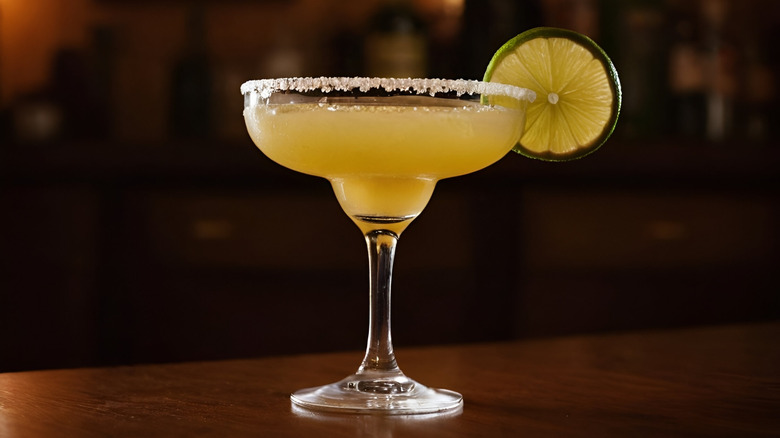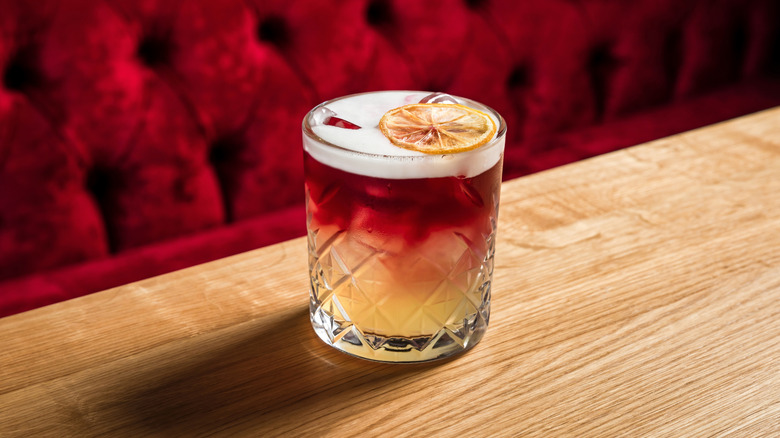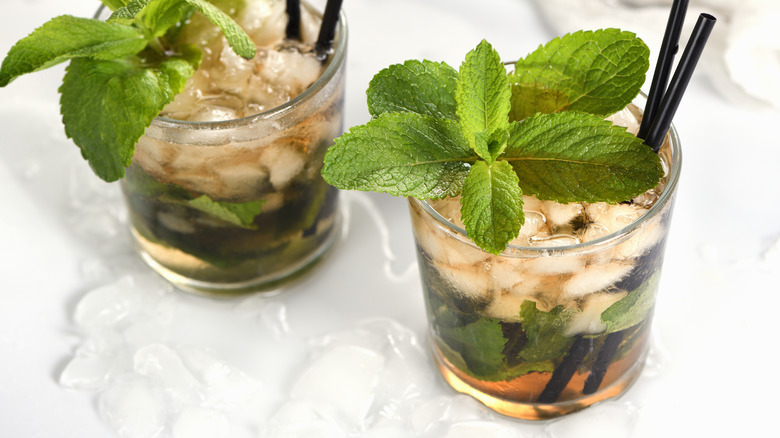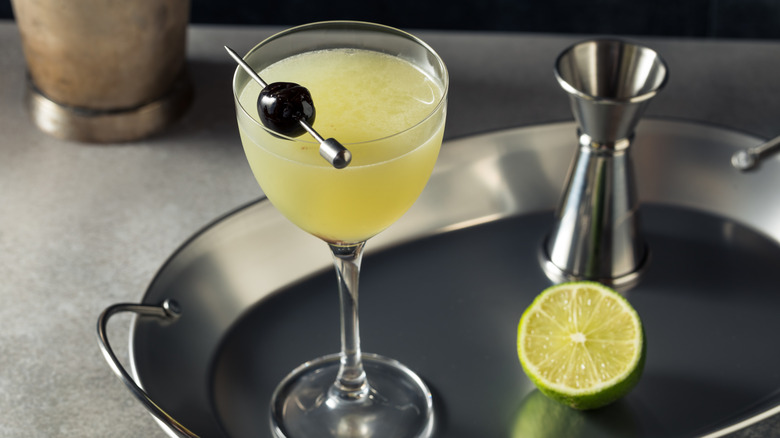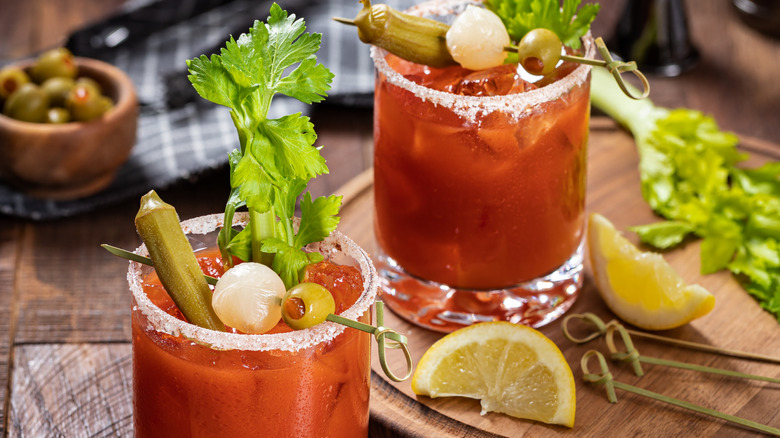Popular Cocktails To Never Order At A Dive Bar
Who doesn't love a good 'ol crusty dive bar? No better venue exists for local charm and people-watching, deplorable toilet facilities, and everyone inside knowing your name. You see your fellow regular patrons in various states of impairment, drifting somewhere between the horizontal and vertical, and bartenders with names like Bob, Mike, or Deb, who seemingly just live there. There is an ever-present crowd of smokers swaying outside, many of whom wear faces that seem to contemplate the meaning of life with each successive drag.
Traditionally known for quick pours, beers, and basic shooters, the term "dive bar" today seems to apply more broadly to quirky, neighborhood hole-in-the-wall-type places, some of which offer creative drinks that will surprise you. But most dives will likely stick to what they do best, which probably isn't cocktails.
Having put in my time as a bartender at various types of joints over the years, I feel pretty comfortable dishing out some rules of thumb for these charming yet colorful staples of the service industry. For the most basic of dives, a good rule of thumb is "nothing shaken, nothing stirred." (That being said, every bar and every bartender is different.) Here are some of the drinks you should stay away from when visiting an establishment that borders on the dive end of the spectrum.
Margarita
The margarita is one of the world's most popular, and surprisingly sophisticated, cocktails. Nothing beats that interplay of sweet, sour, and salty, especially if you use fresh lime juice or sub agave nectar for triple sec or simple syrup.
If you prefer your margaritas frozen or made from a mix, then there's nothing to worry about if you order one at a dive bar, and you can probably stop reading right here. The problem, though, is that dive bars are often unlikely to carry agave nectar or bother about squeezing fresh lime juice. Plus, a great marg requires a vigorous shake, so think again if you want a fresh, perfectly crafted margarita. Even worse is if the bar uses a packaged sour mix that is the color of antifreeze and is in no way related to actual limes. Your best bet is to go DIY and ask for a tequila shot (perhaps chilled), accompanied by a salt shaker and lime wedge.
Martini
Precision matters with a martini, and it's just not the same if it's not served in a glass of the same name. It's 007's drink of choice, after all. Dive bars often lack the vermouth variety and exacting standards needed to make this classic, whether it be shaken or stirred. That being said, if you do see shakers, barspoons, and mixing glasses around the bar top, you may want to ask the bartender what they mix with these, as there could be a house specialty worth trying.
Forget a dirty martini altogether, unless you want a literal dirty martini. Take one look at where the bar stores its olives and try and guess how many fingers have been up in that juice. Given that the martini is basically pure alcohol, you could instead ask for a chilled double shot of vodka or gin and just imagine a lemon twist as you throw it back.
Negroni
An Italian classic, the negroni is often considered a "perfect" cocktail because its three signature ingredients can be mixed in equal measure, though not all places follow this rule. It's also so versatile spirit-wise. My favorite variant of the negroni is to sub mezcal for gin, and whiskey lovers may turn a negroni into a boulevardier by subbing in bourbon.
Sadly, the key ingredient to the negroni, Campari, is not a usual find at dive bars. Also, assuming the bar even has quality vermouth, chances are it wasn't opened in this century and likely has never once been refrigerated. Lastly, since a negroni is all booze and no juice, it's critical this drink be stirred properly (never shaken) in ice before straining over an ice sphere or block. All told, this cocktail probably isn't an ideal choice for a dive bar, unless it happens to be a niche negroni place.
Manhattan
Another precision cocktail, which might very well be the first modern cocktail in America, the Manhattan requires the proper proportions of "2-1-2." For cocktail initiates, that's traditionally 2 ounces of rye whiskey (though more recently bourbon has been a favorite), 1 ounce of sweet vermouth, and two dashes of Angostura bitters. (You can easily remember the proportions of 2-1-2 because it is also Manhattan's original area code.)
Despite seeming simple, this cocktail relies on the precise ratio of quality ingredients, and as I mentioned above for the negroni and martini, vermouth can often be the missing variable in a dive bar. Typically, a Manhattan is garnished with a maraschino cherry (which would be a toss-up at a dive bar) or a lemon twist.
Perhaps consider trying an old fashioned instead, or head to a proper cocktail bar. Expecting a quality Manhattan in a place not set up for serving one is probably not the best approach.
Sours and fizzes
The requirement of egg whites and pisco (a South American brandy) makes the pisco sour complex and characteristically frothy, yet potentially risky if the ingredients aren't fresh. If you're bellying up to a bar in South America, however, this may be an entirely different story. Have five, in that case.
Similarly, you may not be able to rely on a dive bar for the required egg whites to make a New York sour or gin fizz, and if the bar is using a bottled sour mix, you can be extra sure to avoid these classics; otherwise, you'll have to settle for whatever sour mix they have coming out of the gun. You're not going to have the foamy texture and citrus tanginess you can expect at a proper cocktail spot. The closest thing you could get is an amaretto sour, if not a basic whiskey sour.
Sazerac
Invented in America and the official cocktail of New Orleans, the sazerac originated with a cognac base but shifted toward rye whiskey when cognac production in Europe was impacted by an epidemic of invasive phylloxera insects in the 19th century.
Unfortunately for dive bar patrons, this drink needs absinthe or an absinthe substitute, Peychaud's bitters, and careful preparation, which might be a stretch at a dive bar. I remember my first time looking into the recipe, wondering what in the hell an "absinthe rinse" was. The bartender actually pours a splash of absinthe into the glass, swirls it around, and dumps the excess. When done correctly, the sazerac is a great go-to cocktail.
There's really no way to reliably make a sazerac substitute. The bartender could try rinsing the glass with ouzo or sambuca, but it still won't be the same without the dash of Peychaud's. Unless you're bar-hopping on Bourbon Street, you may want to skip this one at your friendly neighborhood dive.
Mojitos and daiquiris
We're getting into Hemingway territory now with our rum cocktails. The mojito is a Cuban rum-based classic that has a history as opaque as the drink itself; it's considered to be one of the oldest cocktails still in existence. The drink's refreshing mix of sweet and tangy flavors requires fresh lime juice, mint, and a careful muddling process to properly express the oils in the delicate mint leaves.
The mojito kind of screams tropical, beach environments more than it does those of a dank dive bar. If you're still craving one, though, and the bartenders aren't forthcoming, you may be able to get by with the mojito's less sophisticated cousin, the Cuba libre (rum, lime, and cola).
The daiquiri is believed to have originated near a Cuban beach of the same name. While much simpler than the mojito, it still requires a precise balancing of rum, fresh lime juice, and sugar, which, again, means that the quality of the ingredients is of the utmost importance. The simplicity of the ingredients means there's no room for error — if the lime isn't fresh or the rum is subpar, the drink will suffer. Additionally, the precision needed to balance sweet and sour may not be a priority in a fast-paced dive bar setting.
Mint julep
Like the mojito, this Southern Comfort-style drink requires fresh mint and crushed ice, as well as bourbon substituted for the white rum. The mint muddling and ice preparation will likely be beyond the repertoire of most dives, unless you're attending on the day of the Kentucky Derby, on which as many as 120,000 of these cocktails are made during the event itself. Though a bit more obscure today, this is another example of a refreshing drink more associated with warm climates and elegant derby hats than it is crusty dive bars.
If the dive bar happens to carry fresh mint, however, an easy mint julep substitute would be the classic whiskey smash. All your bartender needs to do is add 2 ounces of bourbon, some mint leaves, a few lemon wedges, and simple syrup to a bar glass. After adding ice, they'll shake it vigorously, so the ice breaks down a little bit, before dumping the whole concoction into a teardrop glass and serving with a fresh sprig of mint as a garnish.
Liqueur-heavy cocktails
It almost goes without saying, but liqueur-heavy cocktails like the aviation, last word, and naked and famous are pretty much out of the question. These all need various specialty liqueurs, like crème de violette, maraschino, and the French alpine Chartreuse, which are rarely stocked at dives, and none of which can be passably substituted by something else.
I once ordered a naked and famous at a legit cocktail bar that happened to be out of Chartreuse at the time. The bartender substituted absinthe for the alpine liqueur without telling me, and I could instantly tell something was off. You maybe, just maybe, will be able to get away with a Ferrari — equal parts Fernet-Branca (also known as The Bartender's Handshake) and Campari, if you're at a dive that happens to carry both of these beloved Italian amaros (bitter liqueurs).
Bloody mary
Similarly to the margarita, you don't want one of these if it comes from a mix. Any bar worth its salt makes its own house bloody mary mix in the kitchen, which, take it from me, takes a lot more effort than you might think but makes a world of difference.
I remember the first time I learned how to use an industrial can opener to rip the lids off of some 12 large cans of tomato juice in one go before mixing in all kinds of spices, diced shallots, and even horseradish into the largest Cambro on hand, and then using a sword-sized blender to mix it all together.
If you're one of the diehards who insist on asking for a can of plain tomato juice and any condiments or hot sauces stocked at the bar to DIY your own bloody mary, then good luck, and Godspeed. Dive or not, be sure to never order one of these past 4 p.m., as bartenders everywhere consider that to be an act of abomination. If it's 3:59, though, no problem whatsoever.
Ramos gin fizz
Whatever you do, for the love of God, please, do not order a Ramos. It's perhaps the most difficult cocktail to master in the libations world, and unsuspecting bartenders are likely going to have to Google it before they ask you to either settle for a salty dog or hit the road.
Firstly, the drink calls for no shortage of the following ingredients: gin, simple syrup, egg whites, citrus, heavy cream, orange flower water, and club soda, which together form the backbone behind such an ideal balance of texture and flavor. But the hardest part is perhaps the shaking. Legend has it that the originator of this cocktail, the old Charles "Carl" Ramos himself, employed a line of "shaker men" who stood by to shake each drink for all they were worth until passing it off to the next man in line when they grew tired. Accounts claim that this drink was shaken for upwards of 15 minutes before being served to the enraptured, and likely quite thirsty, guest. How could you ask Bob or Larry at the old pub for something this demanding?
Well, what do I order?
Since every bar is different, you're going to have to be the best judge of this decision. First, try to read the room: Check the vibe, see what other patrons are drinking, and take a look at whatever glassware options are sitting at the back of the bar. If you see coupes and highball glasses, you may be in luck for a house cocktail special. Check if the establishment has a printed menu with any specialty cocktails.
Do you see shakers or mixing spoons, a stained bottle of bitters? If so, maybe go for an old fashioned? Sounds as simple as syrup, but you'd be surprised at how many bartenders can even botch this classic. Does the overall cleanliness of the place make you ponder the existence of intelligent life lurking in the ice machine? A doubtful look there may rule out the question of our handy dandy mixers – the two-ingredient cocktails with the titles of both ingredients in the name mixed with ice (whisky soda, gin and tonic, and so on). Keep in mind that at a dive bar, the cocktail equivalents are likely going to be various shot combinations.
If we fail that test, and there are no specialty or seasonal cocktails available, we take it back to basics, baby. The classic one-two punch: a shot and a beer. Then duck out and find the next haunt of the night.

